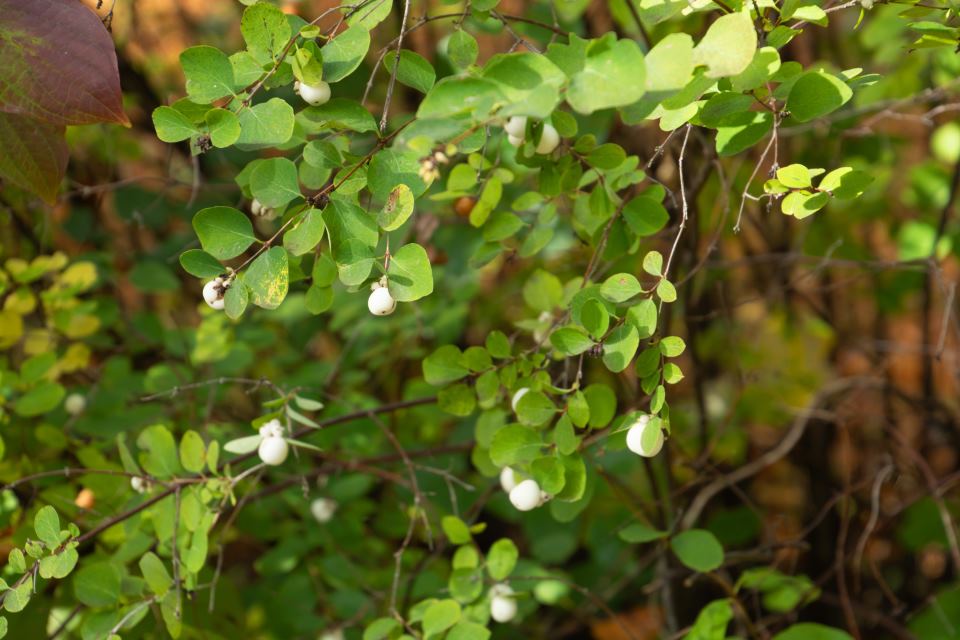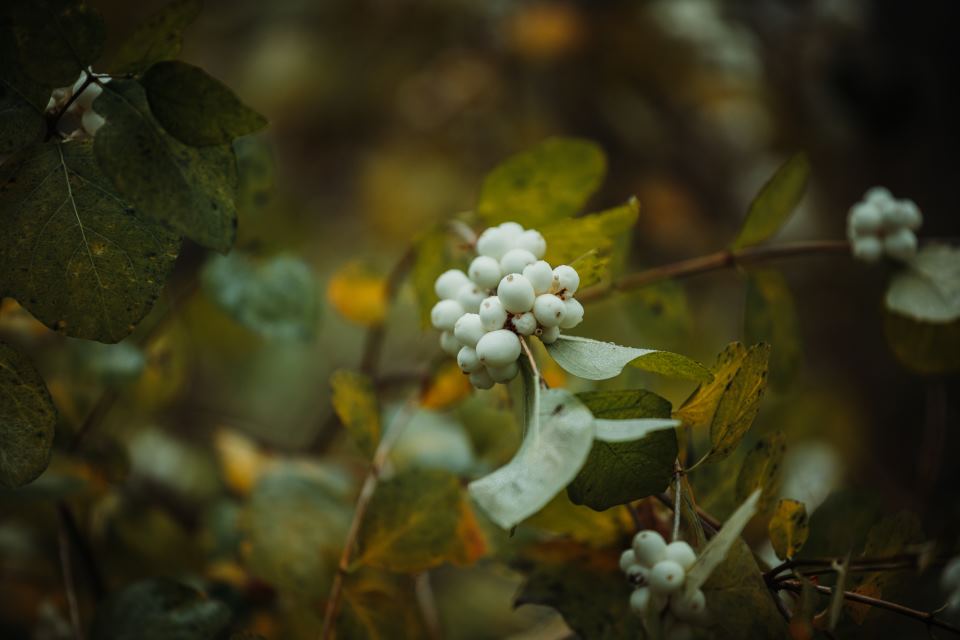Snowberry Bush: How to Grow and Care
Are you looking for a plant that looks beautiful in your garden and has good-looking? Here is the snowberry bush: Snowberry bush, white Snowberry, ghostberry, or common snowberry shrubs is a plant that belongs to the honeysuckle (Caprifoliaceae) family, also known as Symphoricarpos Albus in the botanical world. It’s native to North America, Central America, and Canada.
There are about 15 species of snowberry bush, 12 of which can be found in America and one in China. It’s not considered invasive in America and Canada but in the United Kingdom. Don’t let this scare you; Snowberry is easy to prune. Therefore, a good choice if you start gardening new. It attracts pollinators, host plants, butterflies, and birds. It’s a bonus if you want to see them in your garden. Let’s start with core characteristics so that we can understand basic details.

Core Characteristics
Foliage: Deciduous
Flowering: May-August
Growth Rate: Moderate
Growth Form: Suckering Shrubs
Hardiness Zone: 3-7
Light Requirements: Full Sun to Partial Shade
Mature Height: 3-6 feet tall (91-182 centimeters)
Mature Spread: 4-6 feet tall (121-182 centimeters)
Site Requirements: Tolerates Poor Conditions, Adaptable
Soil Type: Ordinary, Clay, Loam, Sand
Soil Moisture: Dry, Medium, Moist
Type: Self-fertile
Root Type: Rhizome
What Is the Meaning of Its Name?
Snowberry bush has different names, but most come from its snowball-shaped, puffy fruits. When we look at the original name, symphori- means “bear together”, -carpos means “fruits,” and “albus” means “white.” So the common name snowberry refers to snow-white fruits, but what refers to the bush? What does it mean? Why do you see both shrubs and bush? Maybe it looks like an unnecessary detail, but knowing is no harm. Let’s look at the difference below.

Is There Any Difference Between Shrubs and Bush?
Some say there is no difference between shrubs and bush; they’re synonyms. But in reality, there are few differences in their height and physical appearance. Even if these mini differences don’t affect caring and growing directly, it’s worth knowing for botanic knowledge.
Shrubs are the small-to-medium-sized plant that is smaller than a tree. On the contrary, herbaceous plants have multiple persistent stems branching from the ground. As a result, they’re taller than a bush.
Bush means a small cluster of shrubs as one plant and mostly refers plant’s shape. Generally, they grow wildly, while shrubs can be groomed and pruned.
The Appearance of Snowberry Bush
Snowberry blossoms are light pink and snow-white flowers during spring and summer, between May and August. These light pink and snow-white flowers cluster at the end of branches. In fall, these flowers are replaced by white, bell-shaped fruits which can be measured up to 2 inches long (5 centimeters).
Each contains two seeds. The Snowberry’s leaves are light green-blue and scented. The underside of the leaves is hairy and pale. Depending on their species, they can be elliptical, ovate, or reddish-brown oak-leaf shaped when aged. Snowberry measures up to 3-6 feet tall (91-182 centimeters) long and lives for at least 40 years, so they are perennial.
Since its deciduous shrubs, they lose leaves in the winter. Snowberry fruits ripen during fall, between September and October, persisting through the winter. Fruits and flowers have a snowy dreamland look from far, so Snowberry would look good in your garden.

Now we can learn the basic steps of Snowberry’s growing process.
Soil
Snowberry can grow in any soil, prefers loam and clay but also grows well in well-drained, sandy, and rocky soils. It tolerates dry, poor soils and poor nutrient conditions where other plants may fail. Soil pH of Snowberry is acidic to alkaline (circumneutral, between pH 6.8-7.2). It has a high tolerance for CaCO3. Dry, medium and moist soil is suitable for Snowberry. They are commonly found in areas closer to the streams and swamp thickets.
Water
Water snowberry regularly until roots are established. Once they are established, they will tolerate drought so they can be left to grow naturally. Water usage of Snowberry is low-medium. However, regular watering may improve the health and appearance of your plant. Don’t forget to water enough the keep the soil wet, not saturated. Since it’s a drought-resistant plant, additional watering during hot and dry periods is a good idea.
Light
Plant snowberry in full sun or partial shade. The best flowering will happen in a site that receives full sunlight, but Snowberry will grow and flower in partial shade. It can also be grown in full shade but may not produce fruits efficiently.

Temperature and Humidity
Snowberry is not only drought-resistant but also a cold-hardy plant. It’s capable of resisting frost, surviving in harsh temperatures like -40°F (-40 °C) since its zone 3 plant. In addition, Snowberry can tolerate all humidity levels.
Fertilizer
If the snowberry plant is in clay or nutrient-deprived soil, fertilize once in the spring and mid-summer. It doesn’t require annual fertilization but will appreciate balanced fertilizer every other year. Balanced fertilizer benefits shrubs. If Snowberry is planted in rich-nutrient, organic soil, only fertilize once in spring. Use a balanced, water-based 20-20-20 (% 20 nitrogen,% 20 phosphorus,% 20 potassium) fertilizer. Granular fertilizer also can be used but requires specific measurement.
Propagation
You can propagate Snowberry by different methods like seed, stem cutting, and root cutting. So let’s check the process for these methods.
Seed: First, cutting or transplanting suckers is faster than seeding, but seeding is also preferable if you can deal with a great waiting time. Don’t forget that this method’s germination process is pretty long, and some seeds can remain dormant in the soil for approximately ten years. Therefore, you can improve the germination rate by stratifying and scarifying the seeds. Each berry contains two seeds. Start with removing the seeds and cleaning the moist.
Scarification: Scarification will help to weaken and cut the seed coat. By stratifying, seeds think winter is over and growing time has arrived. Plant the seed in a well-drained area; heavy soil is preferable. You can use the dirt for covering up seeds and water to avoid drying out. To soften the seed coat and increase the germination rate, keep the seed at 75-80°F (23-26°C) for 90 days. You can keep the seeds, but they will probably be overwintered during the first winter. Therefore, you may plant the seedlings in the spring. Since it’s their first winter, they need extra care.

Stem Cutting: Propagate through cuttings and collect 4-6 inches (10-15 centimeters) at the end of summer and early fall. Place them in the nursery or seedling soil mix. Keep them outdoors and protect them from direct sun. Don’t forget to provide constant moisture. Then, transplant it to the ground or a bigger pot in the spring.
Root Cutting: When you compare seeding and stem cutting, root cutting is easier for growing and caring. First, dig beneath a shrub and find its roots already spreading. Next, cut out 1 foot tall (30 centimeters) sections using pruners. Plant them where you want to grow and ensure the soil is well-drained. That’s all!
Now, we learned the basic parts and needs of the growing process, but how about the caring process? How should we prune? Are there any diseases of Snowberry? Is it used in daily life? Let’s find the answers below.
Pruning and Caring for Snowberry
The caring process starts with pruning. When it’s planted properly, it’s pretty easy to prune Snowberry. If you’re growing Snowberry as a hedge, it needs regular pruning, and spring is the best time to take care. Don’t prune in summer; otherwise, you may not have any berry production in winter. Regular pruning also helps remove diseases and damaged parts of shrubs.
You can use sterilized pruner blades to avoid pruning wounds and care for branches. Trimming should be done after fruiting; balance the shape and size to eliminate dead woods and most fragile branches. The branches will shatter if they’re already dead. You can find them by bending branches.

Common Disease
Even though Snowberry is fest and disease resistant, it can easily be affected by pests and diseases. A fungal disease called anthracnose, rust and powdery mildew are common between snowberry shrubs besides berry rot and leaf spots. Pests such as aphids, scales, and some moths also can cause harm. You can take care of these pests by using some.
Daily Uses
Unfortunately, Snowberry is not edible for humans since it’s toxic but has many uses, including medical treatment for sore eyes and teeth and as a laxative and diuretic. The berries are also used as a shampoo to clean hair.
Conclusion
Even though it’s difficult to grow and care for Snowberry, it’s worth seeing this snowy dreamland attracting birds to your garden in spring. Propagation and pruning processes seem especially troublesome, but if you take care of your Snowberry well, they won’t bother you so much.
Remember that no matter how beautiful snowberry shrubs look good and well-cared, it’s still toxic to humans. Eating causes mild symptoms such as vomiting, dizziness, and slight sedation in children. Of course, watching birds dancing with your snowberry shrubs cause nothing but happiness. Hope to see snowberry shrubs in your garden!
You may also be interested in:
Heartleaf Bergenia (Bergenia Cordifolia): How to Grow and Care


